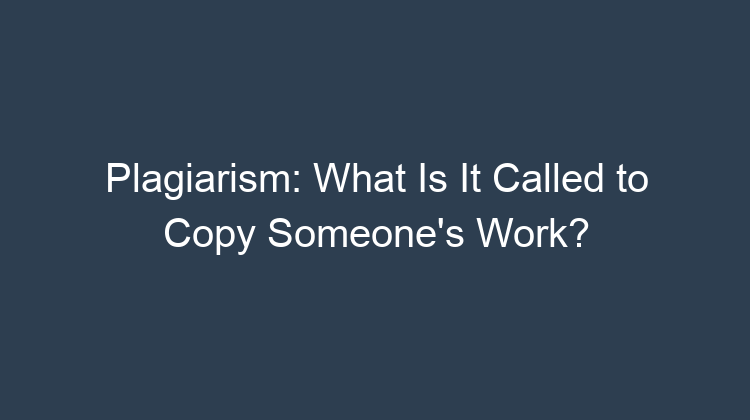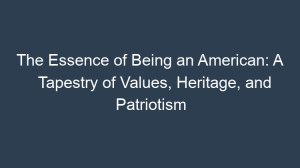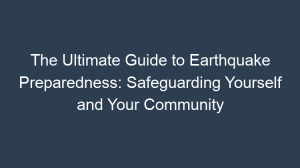The act of copying someone else’s work and passing it off as your own is called plagiarism. It’s a serious academic offense that can have significant consequences, including failing grades, expulsion from school, or even legal action. Whether it’s intentional or unintentional, plagiarism is a form of intellectual theft that undermines the integrity of academic work and the value of a college degree.
Plagiarism can take many forms, including copying text, images, or ideas from another source without giving credit to the original author. It can also involve paraphrasing or summarizing someone else’s work too closely, without adding your own original analysis or interpretation. Even if you change a few words or phrases, if the overall structure and content of your work is substantially similar to someone else’s, it’s still considered plagiarism.
Plagiarism is not only a violation of academic integrity, but it’s also a form of intellectual property theft. When you plagiarize, you are taking credit for someone else’s hard work and creativity. This can have a negative impact on the original author, who may lose out on recognition, compensation, or other opportunities as a result of your actions.
Types of Plagiarism
Direct Plagiarism:
Copying text word-for-word from another source without giving credit to the original author is known as direct plagiarism. This is the most serious form of plagiarism and is always considered academic misconduct. It includes copying entire paragraphs, sentences, or even just a few words verbatim from another source.
Paraphrasing Plagiarism:
Paraphrasing plagiarism occurs when you take someone else’s ideas or information and reword them in your own words without giving credit to the original source. While paraphrasing can be a legitimate way to incorporate information from other sources into your own work, it’s important to avoid plagiarizing by changing only a few words or phrases while keeping the overall structure and content of the original work.
Self-Plagiarism:
Self-plagiarism occurs when you copy your own previously published or submitted work and present it as new without properly citing yourself. While self-plagiarism is not considered as serious as plagiarizing someone else’s work, it’s still a form of academic misconduct and can have negative consequences.
Accidental Plagiarism:
Accidental plagiarism occurs when you unintentionally plagiarize someone else’s work due to lack of proper citation or misunderstanding of plagiarism rules. While accidental plagiarism is not as serious as intentional plagiarism, it can still result in academic penalties if it’s not addressed. It’s important to take the necessary steps to avoid plagiarism, such as properly citing your sources and understanding the rules and guidelines for academic integrity.
Consequences of Plagiarism
Academic Consequences:
Plagiarism can have serious academic consequences, including failing grades, suspension, or even expulsion from school. The severity of the consequences will depend on the nature of the plagiarism, the intent of the student, and the policies of the institution.
Legal Consequences:
In some cases, plagiarism can also have legal consequences. If you plagiarize copyrighted material, you may be subject to copyright infringement lawsuits. This can result in financial penalties, legal fees, and damage to your reputation.
Career Consequences:
Plagiarism can also have a negative impact on your career prospects. Many employers consider plagiarism to be a serious offense and may be reluctant to hire someone who has been found guilty of plagiarism.
How to Avoid Plagiarism
Properly Cite Your Sources:
The best way to avoid plagiarism is to properly cite your sources. This means giving credit to the original author whenever you use their work in your own writing. You can do this by including in-text citations and a reference list at the end of your paper.
Paraphrase Correctly:
When you paraphrase someone else’s work, be sure to change the words, structure, and organization of the original text. Make sure that your paraphrase is substantially different from the original and that you give credit to the original author.
Use Quotation Marks:
If you want to use a direct quote from another source, be sure to put it in quotation marks and include a citation. This will let your reader know that the words are not your own.
Get Help if You Need It:
If you’re not sure how to properly cite your sources or paraphrase someone else’s work, don’t be afraid to ask for help. Your instructor, librarian, or writing center can all provide you with guidance.
FAQ
What is the difference between plagiarism and copyright infringement?
Plagiarism is the act of taking someone else’s work and presenting it as your own, while copyright infringement is the unauthorized use of copyrighted material. Plagiarism can occur even if the work is not copyrighted, while copyright infringement can only occur if the work is protected by copyright.
Can I use someone else’s work if I give them credit?
Yes, you can use someone else’s work if you give them credit. However, you must always get permission from the original author before using their work. This is especially important if you plan to use their work for commercial purposes.
What are the consequences of plagiarism?
The consequences of plagiarism can include failing grades, suspension, or even expulsion from school. It can also have a negative impact on your career prospects. In some cases, plagiarism can also result in legal consequences.
How can I avoid plagiarism?
The best way to avoid plagiarism is to properly cite your sources. You should also paraphrase correctly and use quotation marks when using direct quotes. If you’re not sure how to properly cite your sources or paraphrase someone else’s work, don’t be afraid to ask for help.
What is the difference between plagiarism and self-plagiarism?
Plagiarism is the act of taking someone else’s work and presenting it as your own, while self-plagiarism is the act of copying your own previously published or submitted work and presenting it as new without properly citing yourself. While self-plagiarism is not as serious as plagiarizing someone else’s work, it’s still a form of academic misconduct and can have negative consequences.
Conclusion
Plagiarism is a serious issue that can have significant consequences for students and professionals alike. It’s important to be aware of what plagiarism is and how to avoid it. By properly citing your sources, paraphrasing correctly, and using quotation marks, you can protect yourself from the consequences of plagiarism and maintain your academic and professional integrity.







